AI Software Implementation Project Plan for Toyota Motors
VerifiedAdded on 2022/08/24
|23
|3104
|16
Project
AI Summary
This project plan details the implementation of AI software within Toyota Motors Corporation, addressing the need for enhanced operational strategies. It outlines project objectives, organizational goals, and project scope, emphasizing the use of AI to streamline business processes and improve quality management. The plan covers project assumptions, roles and responsibilities, a timeline with a Gantt chart, risk management strategies, stakeholder management, and project funding. It also includes a PERT diagram analysis and potential drawbacks. The project aims to improve Toyota's operational efficiency and customer service by leveraging AI and machine learning. The project plan includes a detailed risk assessment, stakeholder analysis, and mitigation strategies, ensuring a comprehensive approach to successful AI software implementation.
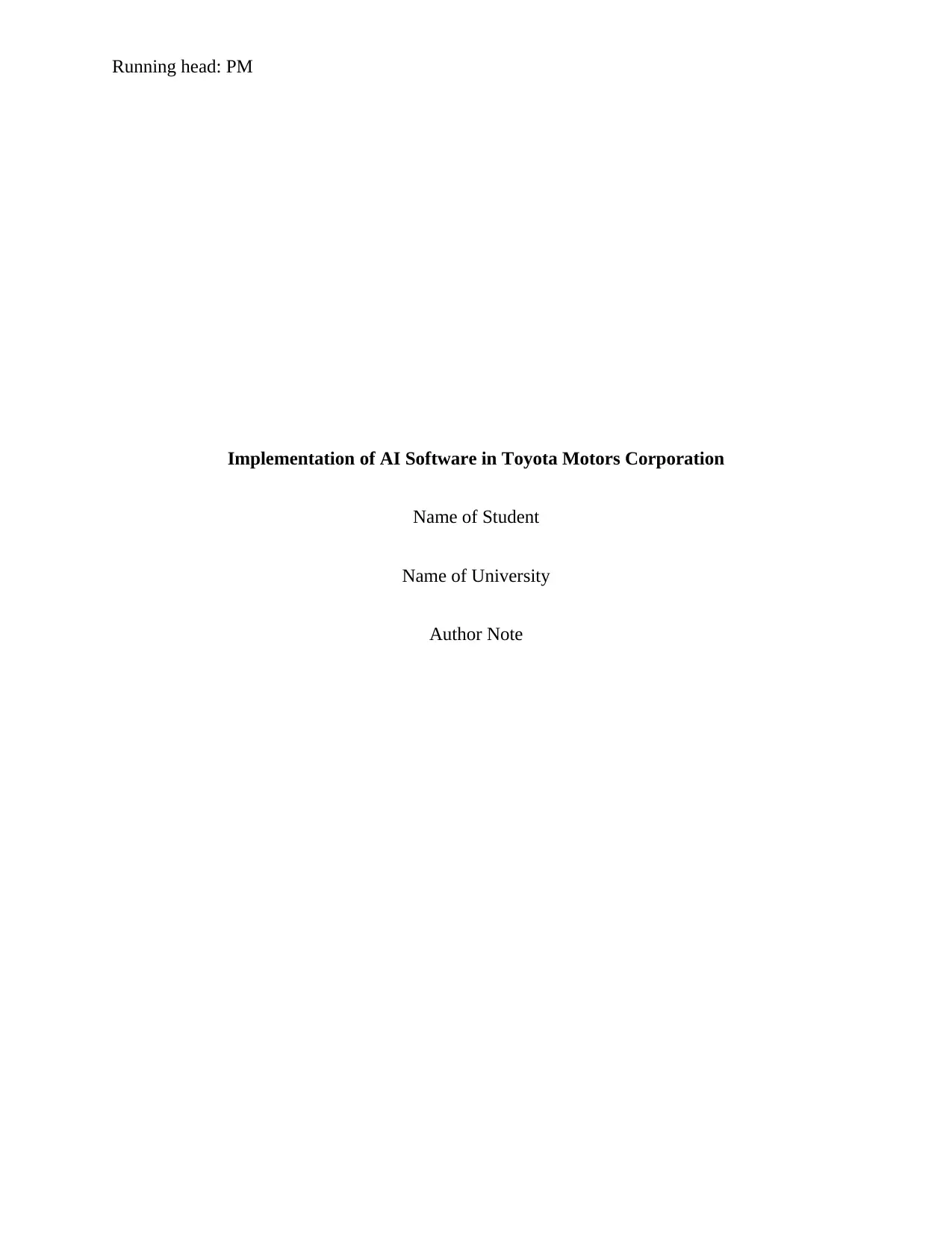
Running head: PM
Implementation of AI Software in Toyota Motors Corporation
Name of Student
Name of University
Author Note
Implementation of AI Software in Toyota Motors Corporation
Name of Student
Name of University
Author Note
Paraphrase This Document
Need a fresh take? Get an instant paraphrase of this document with our AI Paraphraser
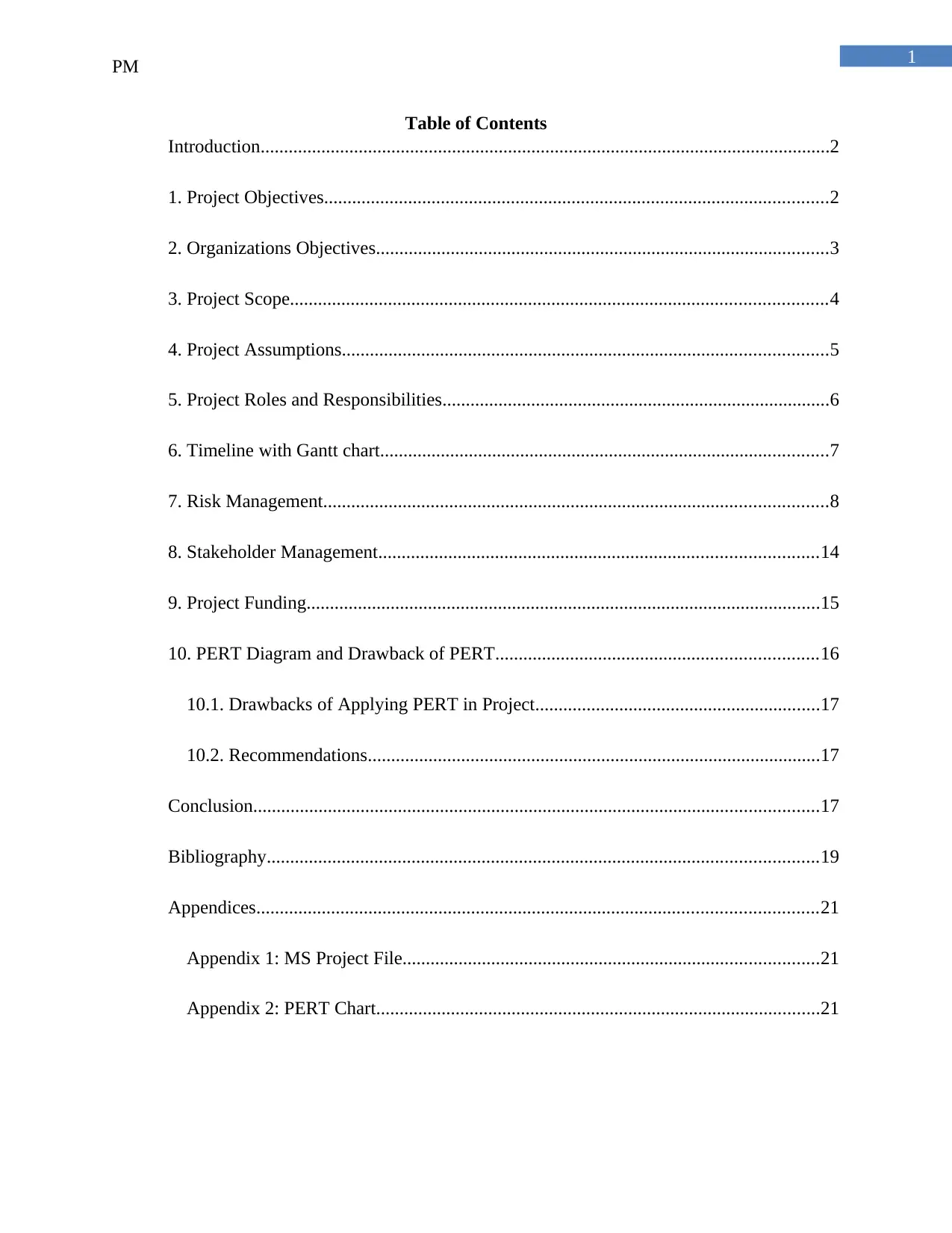
1
PM
Table of Contents
Introduction..........................................................................................................................2
1. Project Objectives............................................................................................................2
2. Organizations Objectives.................................................................................................3
3. Project Scope...................................................................................................................4
4. Project Assumptions........................................................................................................5
5. Project Roles and Responsibilities...................................................................................6
6. Timeline with Gantt chart................................................................................................7
7. Risk Management............................................................................................................8
8. Stakeholder Management..............................................................................................14
9. Project Funding..............................................................................................................15
10. PERT Diagram and Drawback of PERT.....................................................................16
10.1. Drawbacks of Applying PERT in Project.............................................................17
10.2. Recommendations.................................................................................................17
Conclusion.........................................................................................................................17
Bibliography......................................................................................................................19
Appendices........................................................................................................................21
Appendix 1: MS Project File.........................................................................................21
Appendix 2: PERT Chart...............................................................................................21
PM
Table of Contents
Introduction..........................................................................................................................2
1. Project Objectives............................................................................................................2
2. Organizations Objectives.................................................................................................3
3. Project Scope...................................................................................................................4
4. Project Assumptions........................................................................................................5
5. Project Roles and Responsibilities...................................................................................6
6. Timeline with Gantt chart................................................................................................7
7. Risk Management............................................................................................................8
8. Stakeholder Management..............................................................................................14
9. Project Funding..............................................................................................................15
10. PERT Diagram and Drawback of PERT.....................................................................16
10.1. Drawbacks of Applying PERT in Project.............................................................17
10.2. Recommendations.................................................................................................17
Conclusion.........................................................................................................................17
Bibliography......................................................................................................................19
Appendices........................................................................................................................21
Appendix 1: MS Project File.........................................................................................21
Appendix 2: PERT Chart...............................................................................................21
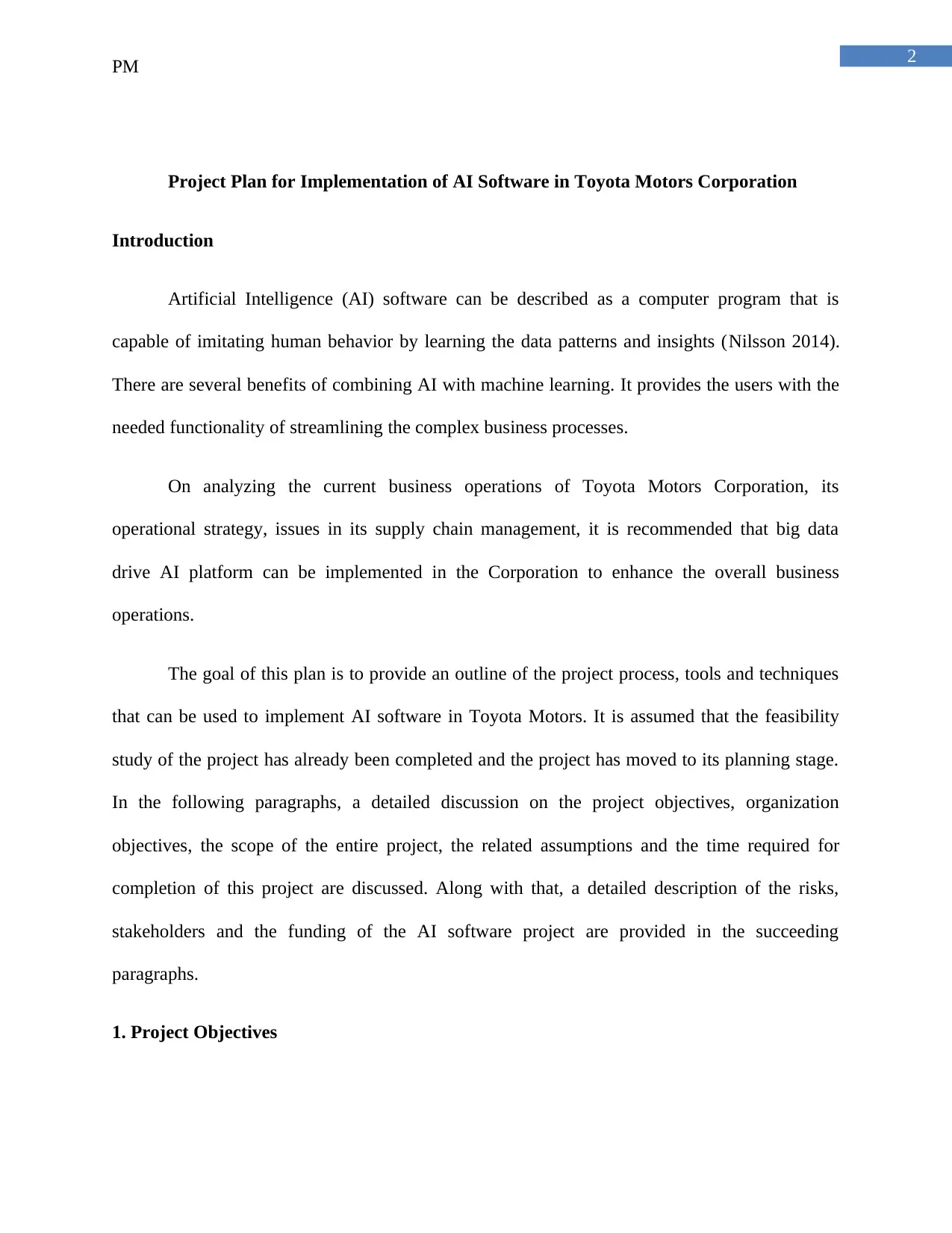
2
PM
Project Plan for Implementation of AI Software in Toyota Motors Corporation
Introduction
Artificial Intelligence (AI) software can be described as a computer program that is
capable of imitating human behavior by learning the data patterns and insights (Nilsson 2014).
There are several benefits of combining AI with machine learning. It provides the users with the
needed functionality of streamlining the complex business processes.
On analyzing the current business operations of Toyota Motors Corporation, its
operational strategy, issues in its supply chain management, it is recommended that big data
drive AI platform can be implemented in the Corporation to enhance the overall business
operations.
The goal of this plan is to provide an outline of the project process, tools and techniques
that can be used to implement AI software in Toyota Motors. It is assumed that the feasibility
study of the project has already been completed and the project has moved to its planning stage.
In the following paragraphs, a detailed discussion on the project objectives, organization
objectives, the scope of the entire project, the related assumptions and the time required for
completion of this project are discussed. Along with that, a detailed description of the risks,
stakeholders and the funding of the AI software project are provided in the succeeding
paragraphs.
1. Project Objectives
PM
Project Plan for Implementation of AI Software in Toyota Motors Corporation
Introduction
Artificial Intelligence (AI) software can be described as a computer program that is
capable of imitating human behavior by learning the data patterns and insights (Nilsson 2014).
There are several benefits of combining AI with machine learning. It provides the users with the
needed functionality of streamlining the complex business processes.
On analyzing the current business operations of Toyota Motors Corporation, its
operational strategy, issues in its supply chain management, it is recommended that big data
drive AI platform can be implemented in the Corporation to enhance the overall business
operations.
The goal of this plan is to provide an outline of the project process, tools and techniques
that can be used to implement AI software in Toyota Motors. It is assumed that the feasibility
study of the project has already been completed and the project has moved to its planning stage.
In the following paragraphs, a detailed discussion on the project objectives, organization
objectives, the scope of the entire project, the related assumptions and the time required for
completion of this project are discussed. Along with that, a detailed description of the risks,
stakeholders and the funding of the AI software project are provided in the succeeding
paragraphs.
1. Project Objectives
⊘ This is a preview!⊘
Do you want full access?
Subscribe today to unlock all pages.

Trusted by 1+ million students worldwide
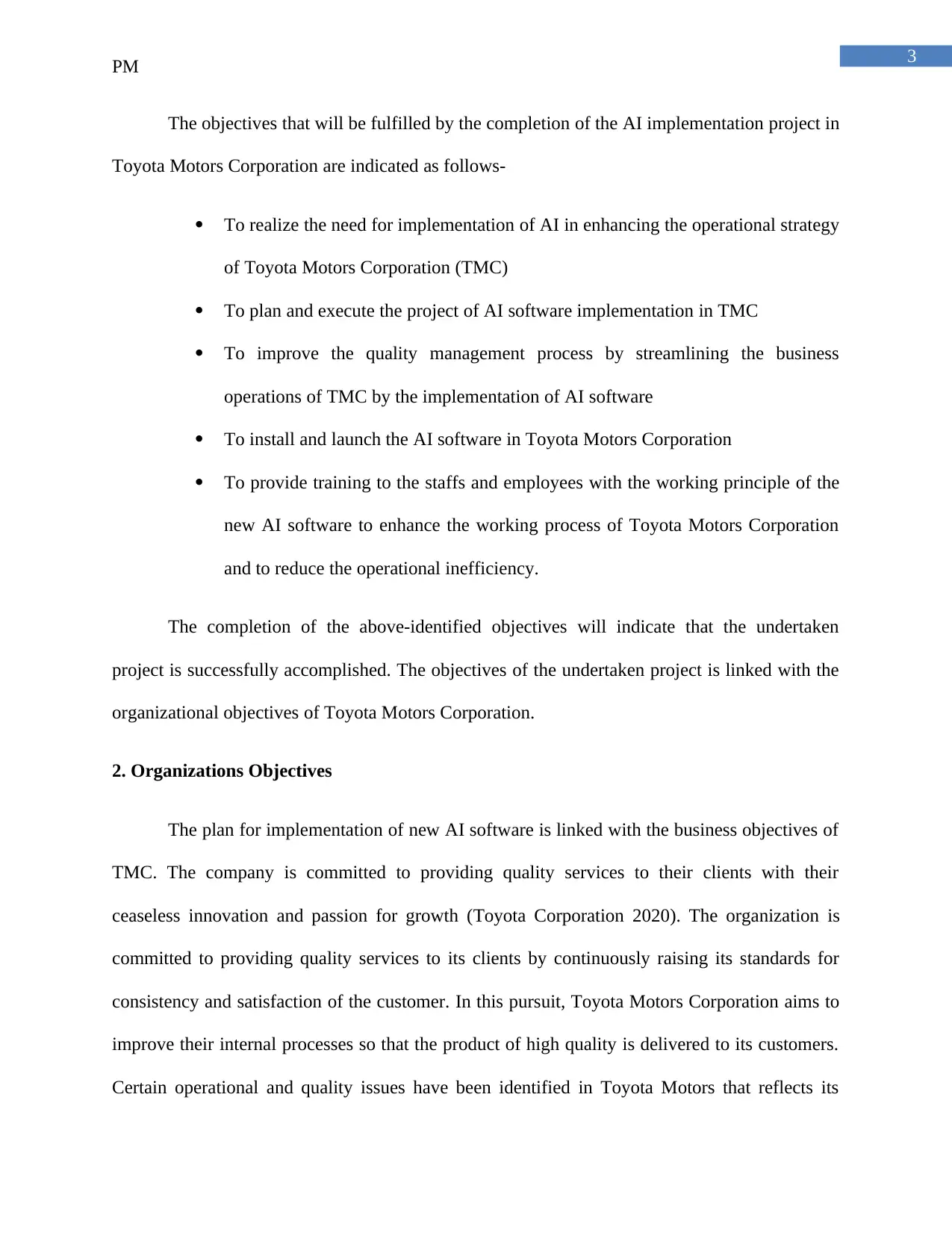
3
PM
The objectives that will be fulfilled by the completion of the AI implementation project in
Toyota Motors Corporation are indicated as follows-
To realize the need for implementation of AI in enhancing the operational strategy
of Toyota Motors Corporation (TMC)
To plan and execute the project of AI software implementation in TMC
To improve the quality management process by streamlining the business
operations of TMC by the implementation of AI software
To install and launch the AI software in Toyota Motors Corporation
To provide training to the staffs and employees with the working principle of the
new AI software to enhance the working process of Toyota Motors Corporation
and to reduce the operational inefficiency.
The completion of the above-identified objectives will indicate that the undertaken
project is successfully accomplished. The objectives of the undertaken project is linked with the
organizational objectives of Toyota Motors Corporation.
2. Organizations Objectives
The plan for implementation of new AI software is linked with the business objectives of
TMC. The company is committed to providing quality services to their clients with their
ceaseless innovation and passion for growth (Toyota Corporation 2020). The organization is
committed to providing quality services to its clients by continuously raising its standards for
consistency and satisfaction of the customer. In this pursuit, Toyota Motors Corporation aims to
improve their internal processes so that the product of high quality is delivered to its customers.
Certain operational and quality issues have been identified in Toyota Motors that reflects its
PM
The objectives that will be fulfilled by the completion of the AI implementation project in
Toyota Motors Corporation are indicated as follows-
To realize the need for implementation of AI in enhancing the operational strategy
of Toyota Motors Corporation (TMC)
To plan and execute the project of AI software implementation in TMC
To improve the quality management process by streamlining the business
operations of TMC by the implementation of AI software
To install and launch the AI software in Toyota Motors Corporation
To provide training to the staffs and employees with the working principle of the
new AI software to enhance the working process of Toyota Motors Corporation
and to reduce the operational inefficiency.
The completion of the above-identified objectives will indicate that the undertaken
project is successfully accomplished. The objectives of the undertaken project is linked with the
organizational objectives of Toyota Motors Corporation.
2. Organizations Objectives
The plan for implementation of new AI software is linked with the business objectives of
TMC. The company is committed to providing quality services to their clients with their
ceaseless innovation and passion for growth (Toyota Corporation 2020). The organization is
committed to providing quality services to its clients by continuously raising its standards for
consistency and satisfaction of the customer. In this pursuit, Toyota Motors Corporation aims to
improve their internal processes so that the product of high quality is delivered to its customers.
Certain operational and quality issues have been identified in Toyota Motors that reflects its
Paraphrase This Document
Need a fresh take? Get an instant paraphrase of this document with our AI Paraphraser
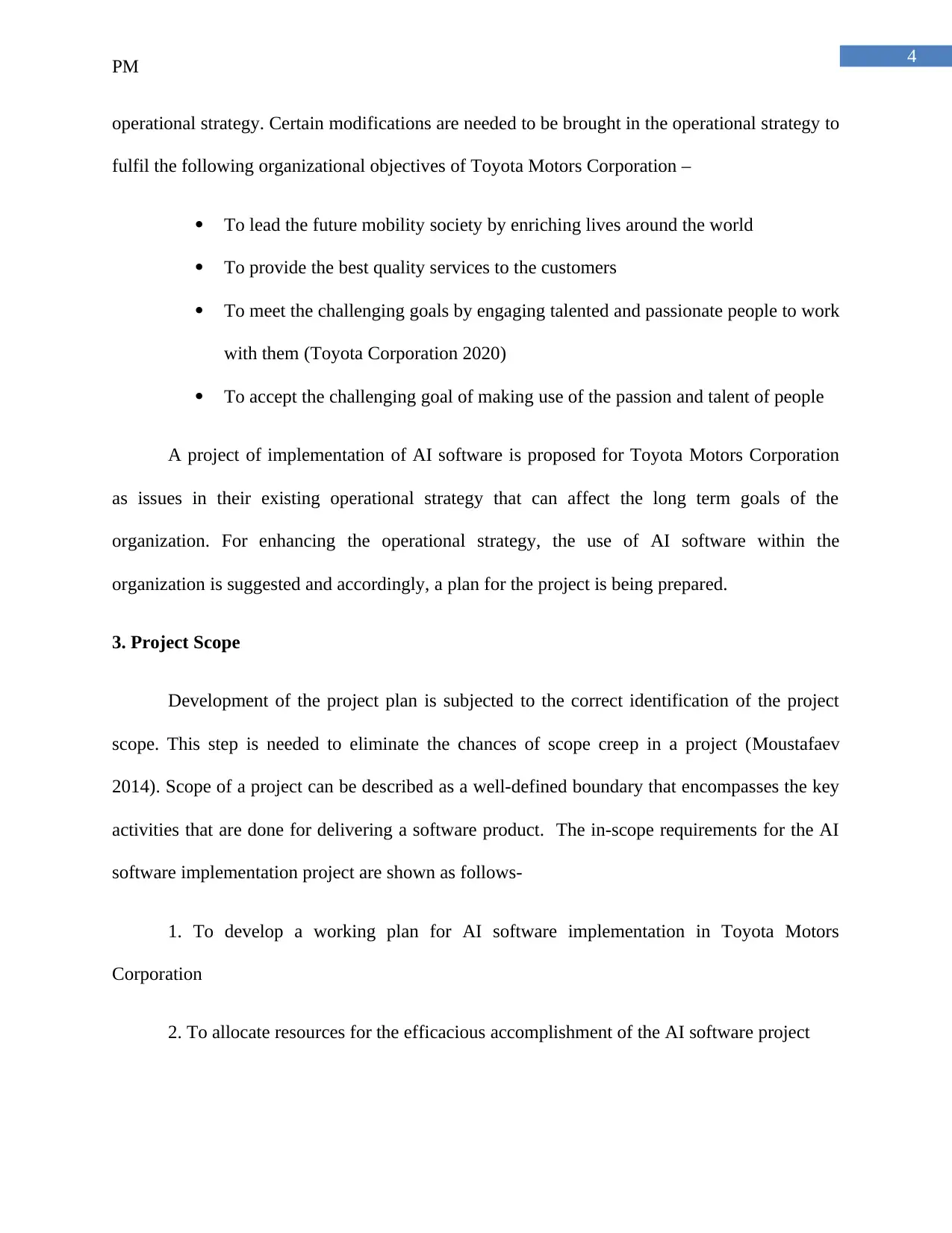
4
PM
operational strategy. Certain modifications are needed to be brought in the operational strategy to
fulfil the following organizational objectives of Toyota Motors Corporation –
To lead the future mobility society by enriching lives around the world
To provide the best quality services to the customers
To meet the challenging goals by engaging talented and passionate people to work
with them (Toyota Corporation 2020)
To accept the challenging goal of making use of the passion and talent of people
A project of implementation of AI software is proposed for Toyota Motors Corporation
as issues in their existing operational strategy that can affect the long term goals of the
organization. For enhancing the operational strategy, the use of AI software within the
organization is suggested and accordingly, a plan for the project is being prepared.
3. Project Scope
Development of the project plan is subjected to the correct identification of the project
scope. This step is needed to eliminate the chances of scope creep in a project (Moustafaev
2014). Scope of a project can be described as a well-defined boundary that encompasses the key
activities that are done for delivering a software product. The in-scope requirements for the AI
software implementation project are shown as follows-
1. To develop a working plan for AI software implementation in Toyota Motors
Corporation
2. To allocate resources for the efficacious accomplishment of the AI software project
PM
operational strategy. Certain modifications are needed to be brought in the operational strategy to
fulfil the following organizational objectives of Toyota Motors Corporation –
To lead the future mobility society by enriching lives around the world
To provide the best quality services to the customers
To meet the challenging goals by engaging talented and passionate people to work
with them (Toyota Corporation 2020)
To accept the challenging goal of making use of the passion and talent of people
A project of implementation of AI software is proposed for Toyota Motors Corporation
as issues in their existing operational strategy that can affect the long term goals of the
organization. For enhancing the operational strategy, the use of AI software within the
organization is suggested and accordingly, a plan for the project is being prepared.
3. Project Scope
Development of the project plan is subjected to the correct identification of the project
scope. This step is needed to eliminate the chances of scope creep in a project (Moustafaev
2014). Scope of a project can be described as a well-defined boundary that encompasses the key
activities that are done for delivering a software product. The in-scope requirements for the AI
software implementation project are shown as follows-
1. To develop a working plan for AI software implementation in Toyota Motors
Corporation
2. To allocate resources for the efficacious accomplishment of the AI software project
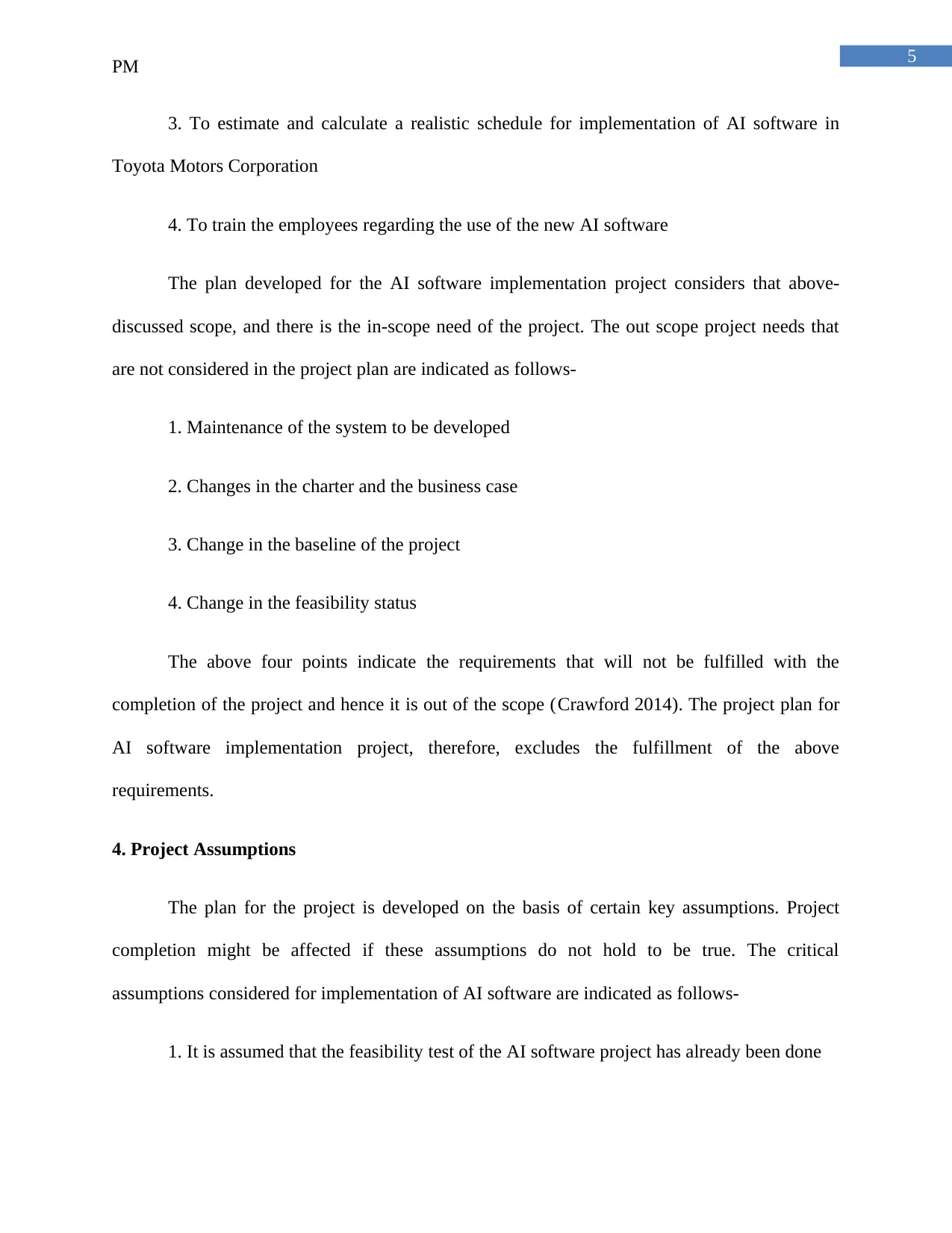
5
PM
3. To estimate and calculate a realistic schedule for implementation of AI software in
Toyota Motors Corporation
4. To train the employees regarding the use of the new AI software
The plan developed for the AI software implementation project considers that above-
discussed scope, and there is the in-scope need of the project. The out scope project needs that
are not considered in the project plan are indicated as follows-
1. Maintenance of the system to be developed
2. Changes in the charter and the business case
3. Change in the baseline of the project
4. Change in the feasibility status
The above four points indicate the requirements that will not be fulfilled with the
completion of the project and hence it is out of the scope (Crawford 2014). The project plan for
AI software implementation project, therefore, excludes the fulfillment of the above
requirements.
4. Project Assumptions
The plan for the project is developed on the basis of certain key assumptions. Project
completion might be affected if these assumptions do not hold to be true. The critical
assumptions considered for implementation of AI software are indicated as follows-
1. It is assumed that the feasibility test of the AI software project has already been done
PM
3. To estimate and calculate a realistic schedule for implementation of AI software in
Toyota Motors Corporation
4. To train the employees regarding the use of the new AI software
The plan developed for the AI software implementation project considers that above-
discussed scope, and there is the in-scope need of the project. The out scope project needs that
are not considered in the project plan are indicated as follows-
1. Maintenance of the system to be developed
2. Changes in the charter and the business case
3. Change in the baseline of the project
4. Change in the feasibility status
The above four points indicate the requirements that will not be fulfilled with the
completion of the project and hence it is out of the scope (Crawford 2014). The project plan for
AI software implementation project, therefore, excludes the fulfillment of the above
requirements.
4. Project Assumptions
The plan for the project is developed on the basis of certain key assumptions. Project
completion might be affected if these assumptions do not hold to be true. The critical
assumptions considered for implementation of AI software are indicated as follows-
1. It is assumed that the feasibility test of the AI software project has already been done
⊘ This is a preview!⊘
Do you want full access?
Subscribe today to unlock all pages.

Trusted by 1+ million students worldwide
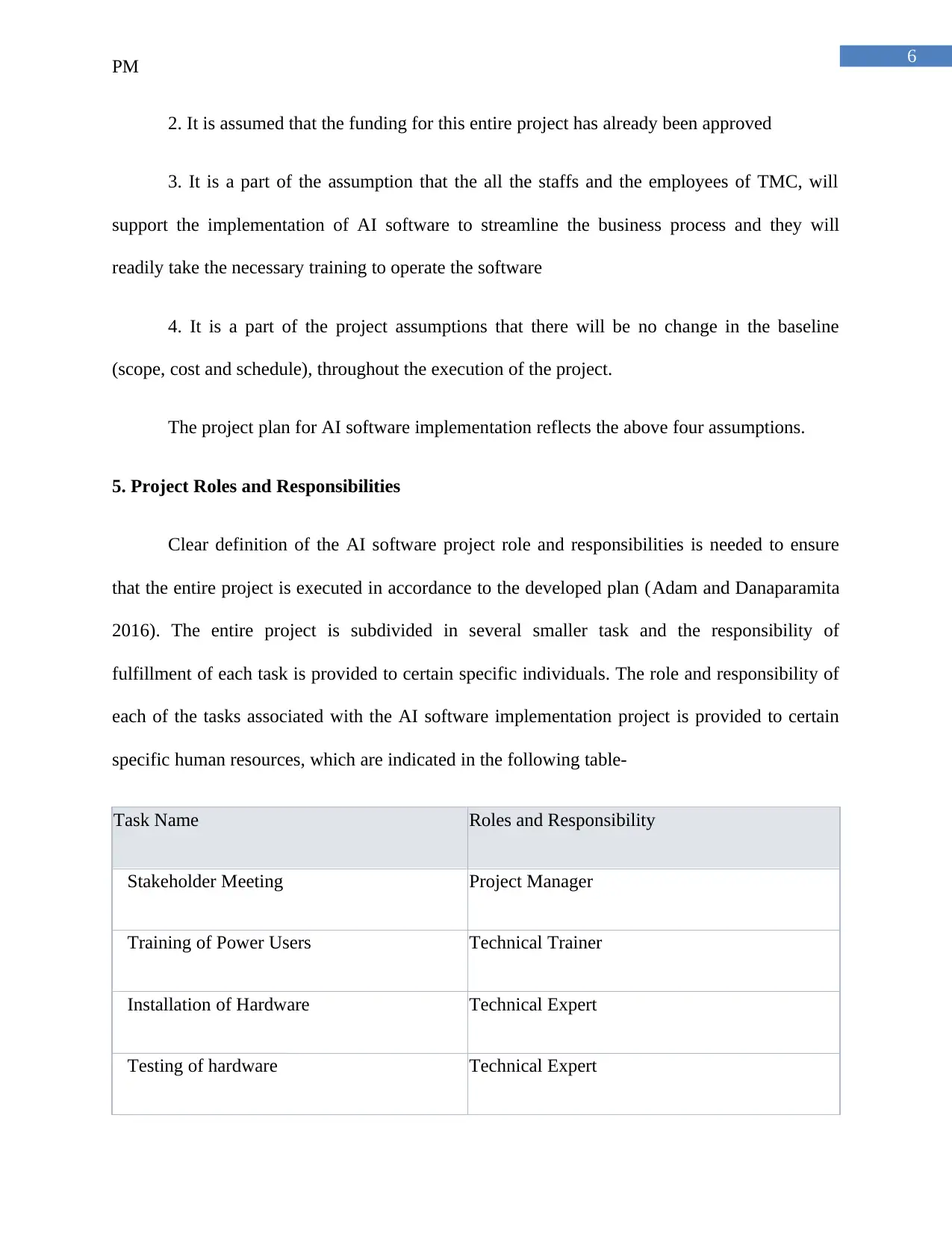
6
PM
2. It is assumed that the funding for this entire project has already been approved
3. It is a part of the assumption that the all the staffs and the employees of TMC, will
support the implementation of AI software to streamline the business process and they will
readily take the necessary training to operate the software
4. It is a part of the project assumptions that there will be no change in the baseline
(scope, cost and schedule), throughout the execution of the project.
The project plan for AI software implementation reflects the above four assumptions.
5. Project Roles and Responsibilities
Clear definition of the AI software project role and responsibilities is needed to ensure
that the entire project is executed in accordance to the developed plan (Adam and Danaparamita
2016). The entire project is subdivided in several smaller task and the responsibility of
fulfillment of each task is provided to certain specific individuals. The role and responsibility of
each of the tasks associated with the AI software implementation project is provided to certain
specific human resources, which are indicated in the following table-
Task Name Roles and Responsibility
Stakeholder Meeting Project Manager
Training of Power Users Technical Trainer
Installation of Hardware Technical Expert
Testing of hardware Technical Expert
PM
2. It is assumed that the funding for this entire project has already been approved
3. It is a part of the assumption that the all the staffs and the employees of TMC, will
support the implementation of AI software to streamline the business process and they will
readily take the necessary training to operate the software
4. It is a part of the project assumptions that there will be no change in the baseline
(scope, cost and schedule), throughout the execution of the project.
The project plan for AI software implementation reflects the above four assumptions.
5. Project Roles and Responsibilities
Clear definition of the AI software project role and responsibilities is needed to ensure
that the entire project is executed in accordance to the developed plan (Adam and Danaparamita
2016). The entire project is subdivided in several smaller task and the responsibility of
fulfillment of each task is provided to certain specific individuals. The role and responsibility of
each of the tasks associated with the AI software implementation project is provided to certain
specific human resources, which are indicated in the following table-
Task Name Roles and Responsibility
Stakeholder Meeting Project Manager
Training of Power Users Technical Trainer
Installation of Hardware Technical Expert
Testing of hardware Technical Expert
Paraphrase This Document
Need a fresh take? Get an instant paraphrase of this document with our AI Paraphraser
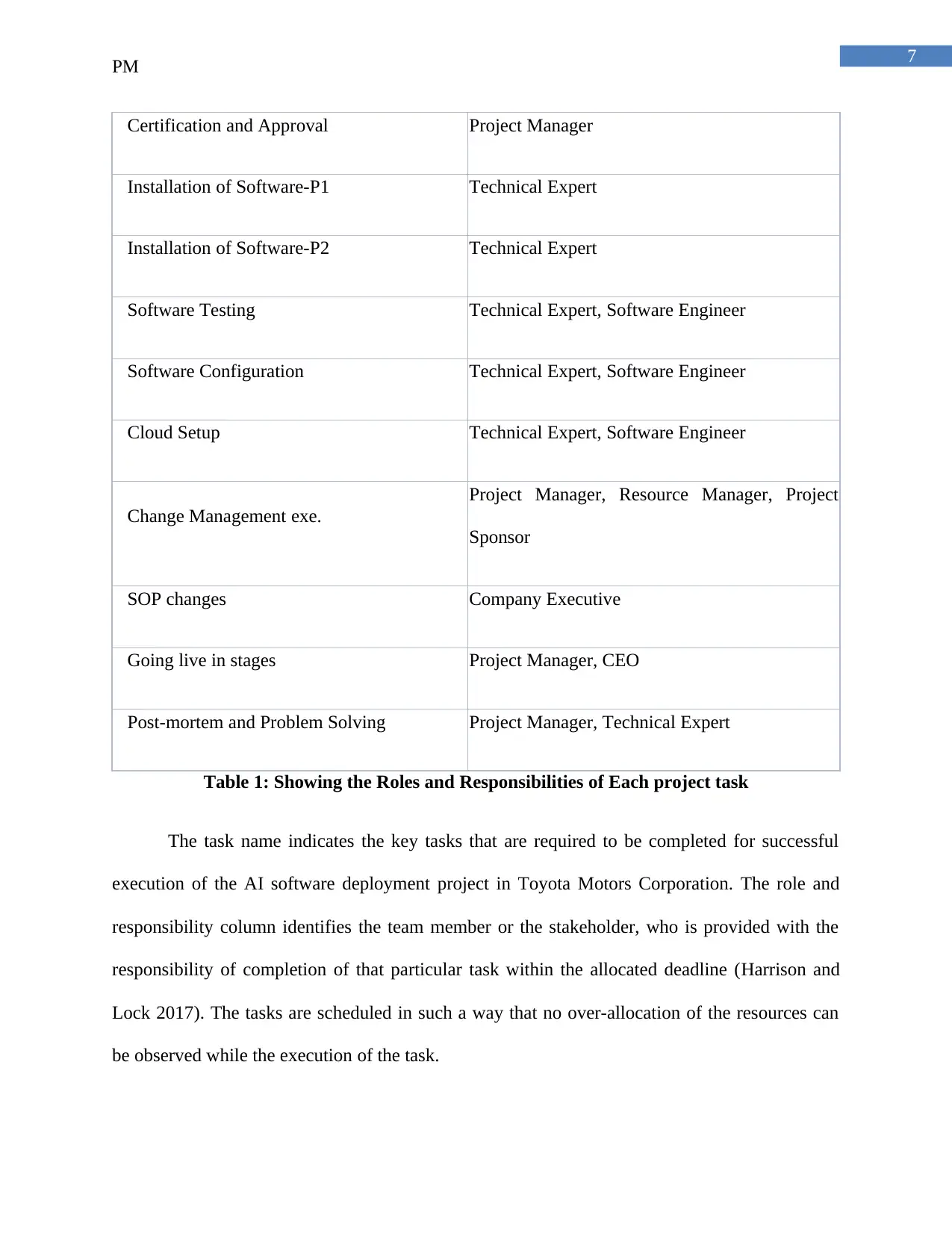
7
PM
Certification and Approval Project Manager
Installation of Software-P1 Technical Expert
Installation of Software-P2 Technical Expert
Software Testing Technical Expert, Software Engineer
Software Configuration Technical Expert, Software Engineer
Cloud Setup Technical Expert, Software Engineer
Change Management exe.
Project Manager, Resource Manager, Project
Sponsor
SOP changes Company Executive
Going live in stages Project Manager, CEO
Post-mortem and Problem Solving Project Manager, Technical Expert
Table 1: Showing the Roles and Responsibilities of Each project task
The task name indicates the key tasks that are required to be completed for successful
execution of the AI software deployment project in Toyota Motors Corporation. The role and
responsibility column identifies the team member or the stakeholder, who is provided with the
responsibility of completion of that particular task within the allocated deadline (Harrison and
Lock 2017). The tasks are scheduled in such a way that no over-allocation of the resources can
be observed while the execution of the task.
PM
Certification and Approval Project Manager
Installation of Software-P1 Technical Expert
Installation of Software-P2 Technical Expert
Software Testing Technical Expert, Software Engineer
Software Configuration Technical Expert, Software Engineer
Cloud Setup Technical Expert, Software Engineer
Change Management exe.
Project Manager, Resource Manager, Project
Sponsor
SOP changes Company Executive
Going live in stages Project Manager, CEO
Post-mortem and Problem Solving Project Manager, Technical Expert
Table 1: Showing the Roles and Responsibilities of Each project task
The task name indicates the key tasks that are required to be completed for successful
execution of the AI software deployment project in Toyota Motors Corporation. The role and
responsibility column identifies the team member or the stakeholder, who is provided with the
responsibility of completion of that particular task within the allocated deadline (Harrison and
Lock 2017). The tasks are scheduled in such a way that no over-allocation of the resources can
be observed while the execution of the task.
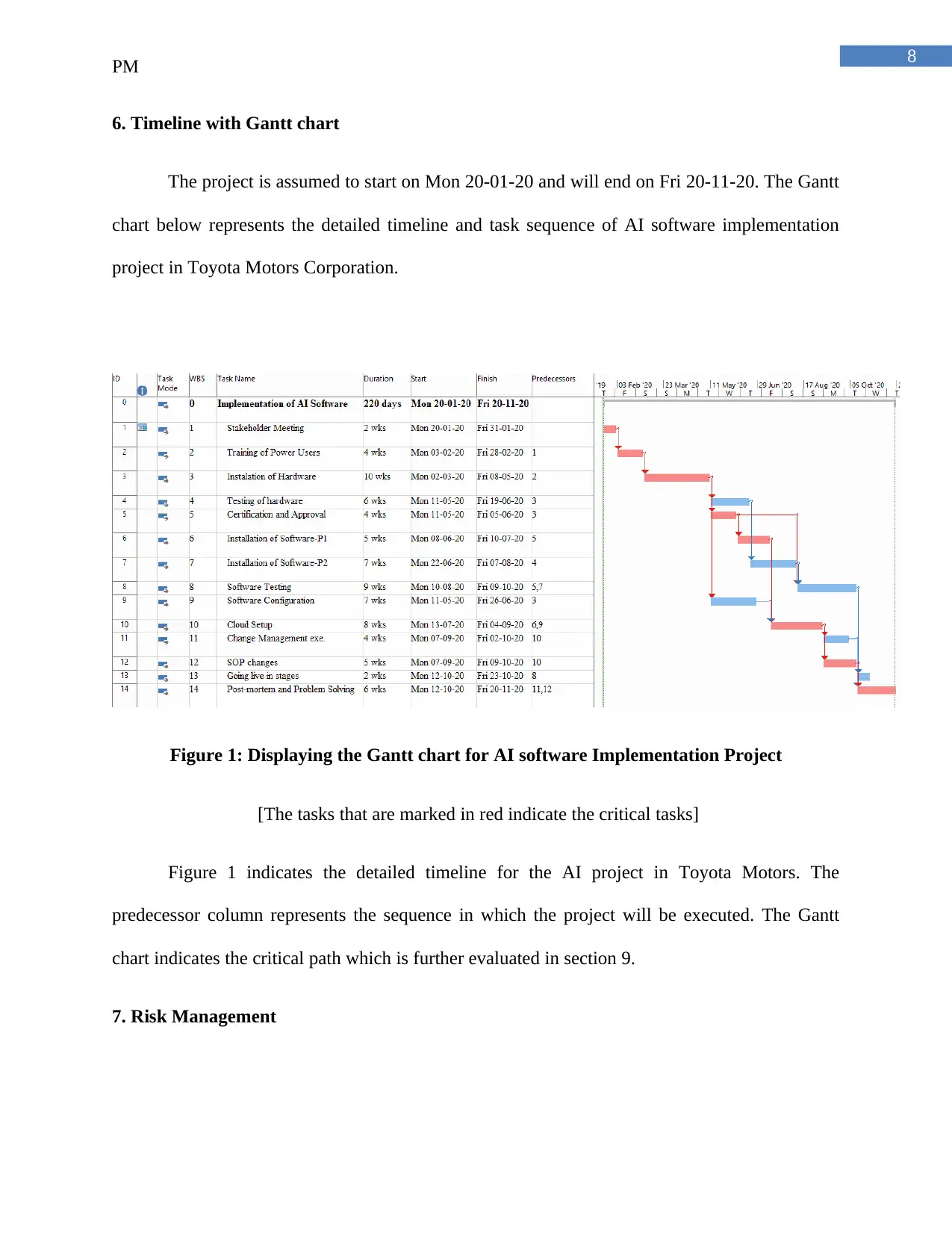
8
PM
6. Timeline with Gantt chart
The project is assumed to start on Mon 20-01-20 and will end on Fri 20-11-20. The Gantt
chart below represents the detailed timeline and task sequence of AI software implementation
project in Toyota Motors Corporation.
Figure 1: Displaying the Gantt chart for AI software Implementation Project
[The tasks that are marked in red indicate the critical tasks]
Figure 1 indicates the detailed timeline for the AI project in Toyota Motors. The
predecessor column represents the sequence in which the project will be executed. The Gantt
chart indicates the critical path which is further evaluated in section 9.
7. Risk Management
PM
6. Timeline with Gantt chart
The project is assumed to start on Mon 20-01-20 and will end on Fri 20-11-20. The Gantt
chart below represents the detailed timeline and task sequence of AI software implementation
project in Toyota Motors Corporation.
Figure 1: Displaying the Gantt chart for AI software Implementation Project
[The tasks that are marked in red indicate the critical tasks]
Figure 1 indicates the detailed timeline for the AI project in Toyota Motors. The
predecessor column represents the sequence in which the project will be executed. The Gantt
chart indicates the critical path which is further evaluated in section 9.
7. Risk Management
⊘ This is a preview!⊘
Do you want full access?
Subscribe today to unlock all pages.

Trusted by 1+ million students worldwide

9
PM
Every software implementation project is linked with a certain amount of risks and
uncertainties that are required to be allayed or managed (Bowers and Khorakian 2014). The
following risk table documents the key risks, their impact and their strategy of mitigation.
PM
Every software implementation project is linked with a certain amount of risks and
uncertainties that are required to be allayed or managed (Bowers and Khorakian 2014). The
following risk table documents the key risks, their impact and their strategy of mitigation.
Paraphrase This Document
Need a fresh take? Get an instant paraphrase of this document with our AI Paraphraser
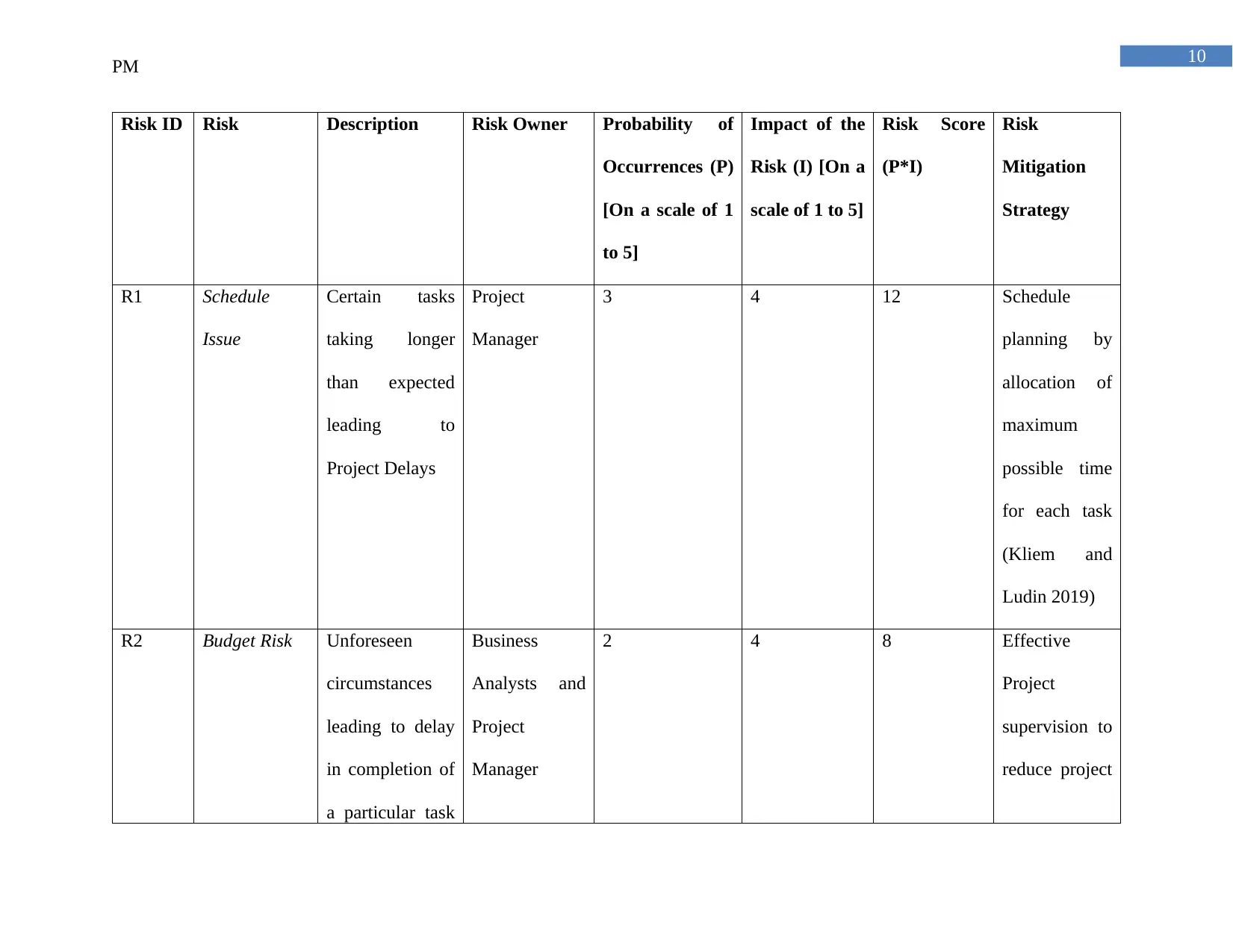
10
PM
Risk ID Risk Description Risk Owner Probability of
Occurrences (P)
[On a scale of 1
to 5]
Impact of the
Risk (I) [On a
scale of 1 to 5]
Risk Score
(P*I)
Risk
Mitigation
Strategy
R1 Schedule
Issue
Certain tasks
taking longer
than expected
leading to
Project Delays
Project
Manager
3 4 12 Schedule
planning by
allocation of
maximum
possible time
for each task
(Kliem and
Ludin 2019)
R2 Budget Risk Unforeseen
circumstances
leading to delay
in completion of
a particular task
Business
Analysts and
Project
Manager
2 4 8 Effective
Project
supervision to
reduce project
PM
Risk ID Risk Description Risk Owner Probability of
Occurrences (P)
[On a scale of 1
to 5]
Impact of the
Risk (I) [On a
scale of 1 to 5]
Risk Score
(P*I)
Risk
Mitigation
Strategy
R1 Schedule
Issue
Certain tasks
taking longer
than expected
leading to
Project Delays
Project
Manager
3 4 12 Schedule
planning by
allocation of
maximum
possible time
for each task
(Kliem and
Ludin 2019)
R2 Budget Risk Unforeseen
circumstances
leading to delay
in completion of
a particular task
Business
Analysts and
Project
Manager
2 4 8 Effective
Project
supervision to
reduce project
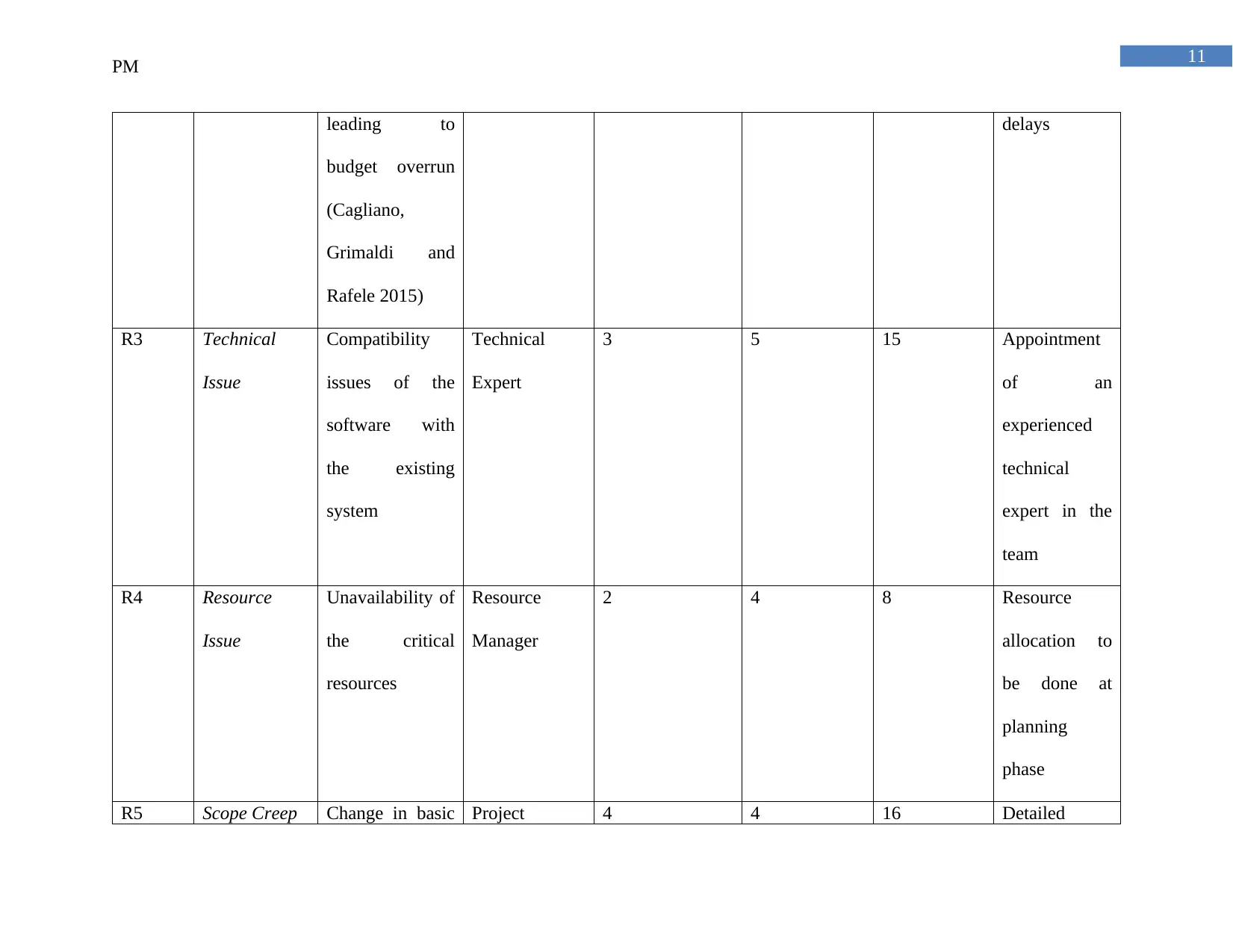
11
PM
leading to
budget overrun
(Cagliano,
Grimaldi and
Rafele 2015)
delays
R3 Technical
Issue
Compatibility
issues of the
software with
the existing
system
Technical
Expert
3 5 15 Appointment
of an
experienced
technical
expert in the
team
R4 Resource
Issue
Unavailability of
the critical
resources
Resource
Manager
2 4 8 Resource
allocation to
be done at
planning
phase
R5 Scope Creep Change in basic Project 4 4 16 Detailed
PM
leading to
budget overrun
(Cagliano,
Grimaldi and
Rafele 2015)
delays
R3 Technical
Issue
Compatibility
issues of the
software with
the existing
system
Technical
Expert
3 5 15 Appointment
of an
experienced
technical
expert in the
team
R4 Resource
Issue
Unavailability of
the critical
resources
Resource
Manager
2 4 8 Resource
allocation to
be done at
planning
phase
R5 Scope Creep Change in basic Project 4 4 16 Detailed
⊘ This is a preview!⊘
Do you want full access?
Subscribe today to unlock all pages.

Trusted by 1+ million students worldwide
1 out of 23
Related Documents
Your All-in-One AI-Powered Toolkit for Academic Success.
+13062052269
info@desklib.com
Available 24*7 on WhatsApp / Email
![[object Object]](/_next/static/media/star-bottom.7253800d.svg)
Unlock your academic potential
Copyright © 2020–2025 A2Z Services. All Rights Reserved. Developed and managed by ZUCOL.



